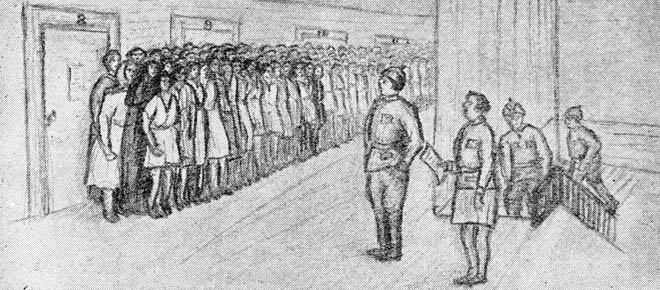|
The GULAG's beginnings
|

In his great work ”The Gulag Archipelago”, Alexander Solzhenitsyn writes that in 1919 the regime had murdered more political opponents than the Romanovs (the last dynasty of the Czars) during their 300-year reign. Furthermore, explains Solzhenitsyn, Russia had more prisoners than the rest of the world together that year.


Right: One of Krylenko’s pamphlets which was published in the West. Not many have survived, partly because they were not the kind of thing democrats wanted on their bookshelves, partly because Krylenko fell out of favour and was executed in Moscow in 1938. After that, his publications were no longer kept by the communists either. In this pamphlet, Krylenko defends the Red terror, of which he became a victim himself.
The first large camp for political prisoners was the Solovki Monastery. Its acronym was “SLUN” which means elephant in Russian. The starting point was the old rules from the times of the Czars, but slowly food rations were reduced, mail was limited, etc. The prisoners began to go on hunger strike, which had a very special meaning in Russia as this was the “weapon” the Bolsheviks themselves had used against the Czars. But after a few tactical concessions in the first few years, the regime also became immune towards the hunger strikers. Hunger strikes were used against the regime right up to the 1980s and are again being used in Putin’s Russia today.
In 1924, a book was published in the West with letters from the political prisoners, especially from the timber camps around Kotlas (where the term Gulag was first used) and Solovki. It brought about a storm of protest in the free world and caused a demand for boycott on Russian timber. It is said that Winston Churchill was one of those behind this demand although I have not been able to find any documentary evidence of this.
Instead of retreating, the Soviet Union chose to recognise what everyone could see. Instead they spoke of the Gulag’s outstanding qualities. The poor prisoners where not allowed to rot in misery, as Justice Commissioner Krylenko put it. No, here the prisoners were permitted to work for the community, and through honest work they were able to become better members of the workers’ state.
The British Timber Federation (an employers’ association) sent two reporters to Kotlas. Their report was reprehensible. It showed they had done absolutely nothing to obtain information other than accept what they were told. They concluded that conditions in Kotlas were better than in Canada’s free timber enterprises. They added that the number of prisoners was drastically exaggerated as “so many prisoners would have cut down all the forests in the Soviet Union”. That was the sort of thing you might expect from raging communists but the fact that it could come from people calling themselves democrats is flabbergasting even today.
What does GULAG mean?
It stands for “Glavnoye Upravleniye Ispravitel'no-Trudovykh Lagerey i koloniy” or “The Chief Administration of Corrective Labour Camps and Colonies”. In fact, it was simply a continuation of the SLUN system but it was given its name in Kotlas north of Moscow through an order in 1928. The name was then adopted for the entire slave camp empire governed by the GPU, under which Kolyma (or Dalstroy) was included, at least officially, as there is evidence that Dalstroy in some cases received orders directly from Stalin himself.
Next: Storm projects